

Compact Muon Solenoid
LHC, CERN
| CMS-SMP-22-010 ; CERN-EP-2024-208 | ||
| Measurement of the Drell-Yan forward-backward asymmetry and of the effective leptonic weak mixing angle in proton-proton collisions at $ \sqrt{s} = $ 13 TeV | ||
| CMS Collaboration | ||
| 14 August 2024 | ||
| PLB 866 (2025) 139526 | ||
| Abstract: The forward-backward asymmetry in Drell-Yan production and the effective leptonic electroweak mixing angle are measured in proton-proton collisions at $ \sqrt{s} = $ 13 TeV, collected by the CMS experiment and corresponding to an integrated luminosity of 138 fb$ ^{-1} $. The measurement uses both dimuon and dielectron events, and is performed as a function of the dilepton mass and rapidity. The unfolded angular coefficient $ A_4 $ is also extracted, as a function of the dilepton mass and rapidity. Using the CT18Z set of parton distribution functions, we obtain $ \sin^2\theta_\text{eff}^{\ell} = $ 0.23152 $ \pm $ 0.00031, where the uncertainty includes the experimental and theoretical contributions. The measured value agrees with the standard model fit result to global experimental data. This is the most precise $ \sin^2\theta_\text{eff}^{\ell} $ measurement at a hadron collider, with a precision comparable to the results obtained at LEP and SLD. | ||
| Links: e-print arXiv:2408.07622 [hep-ex] (PDF) ; CDS record ; inSPIRE record ; HepData record ; CADI line (restricted) ; | ||
| Figures | |

png pdf |
Figure 1:
Dilepton mass resolution, at the Z mass, as a function of the dilepton absolute rapidity, for the $ \mu\mu $, $ \mathrm{e}\mathrm{e} $, $ \mathrm{e}\mathrm{g} $, and $ \mathrm{e}\mathrm{h} $ channels. |

png pdf |
Figure 2:
Misidentification rates in the 2018 samples, for electrons in the 2.0 $ < |\eta| < $ 2.5 bin that pass the single-lepton trigger (SLT): (1) majority (circles) and selective (triangles) charge identification; (2) misidentification of electrons as positrons $ (+|-) $ (open markers) or positrons as electrons $ (-|+) $ (solid markers); (3) true (red), simulation (blue), and data (black). The true charge misidentification rate is evaluated by counting electrons with wrong reconstructed charge using generation-level information; the simulated misidentification rate is evaluated with the method used in data. |

png pdf |
Figure 3:
Same-sign dimuon mass distribution for the 2018 sample. The EW and top quark backgrounds are normalized to the integrated luminosity using NNLO cross sections. The multijet background is evaluated by applying weights to the corresponding multijet-enriched samples. The error bars in the lower panel include statistical and background systematic uncertainties (described in Section 5). |
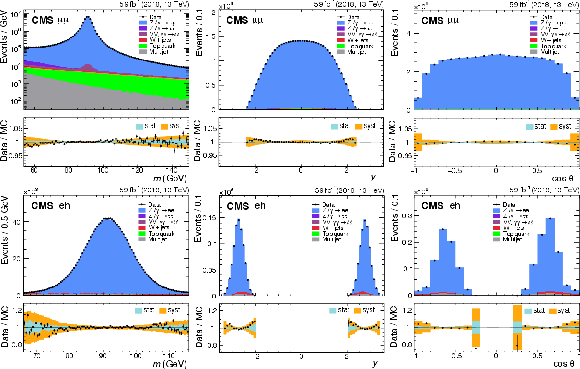
png pdf |
Figure 4:
Lepton $ \cos\theta_\mathrm{CS} $ distribution in $ \mu\mathrm{h} $ events in 2018. The multijet and $ \mathrm{W}\!+\!\text{jets} $ backgrounds are scaled to the data as described in the text. The error bars include statistical and background systematic uncertainties (described in Section 5). |
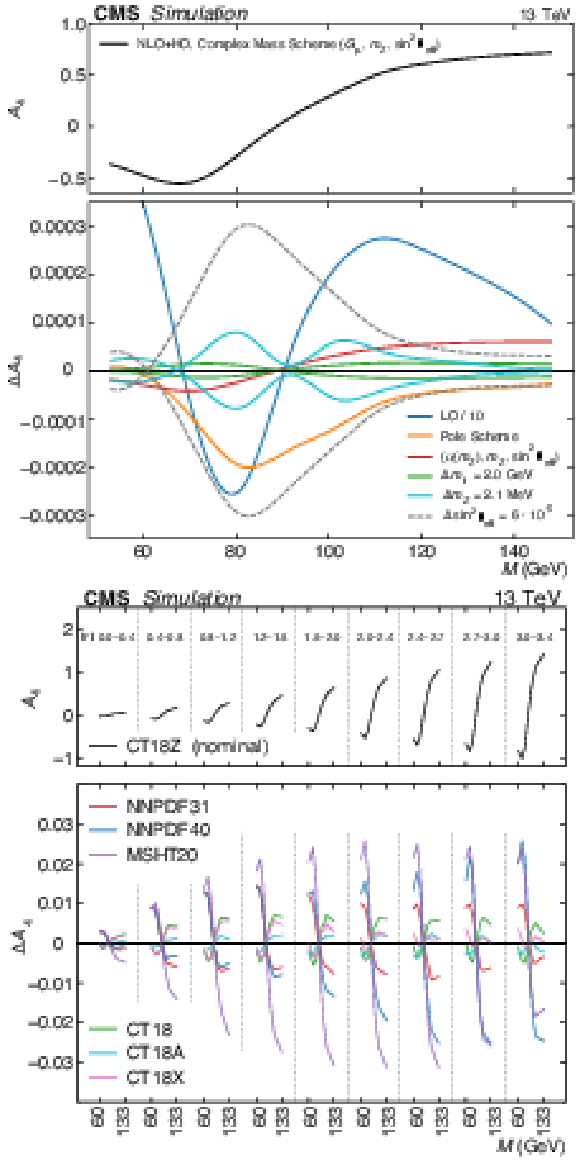
png pdf |
Figure 5:
Dilepton mass (left), rapidity (middle), and $ \cos\theta_\mathrm{CS} $ (right) distributions, for the $ \mu\mu $ (upper) and $ \mathrm{e}\mathrm{h} $ (lower) channels in the 2018 sample, after applying all the corrections. The signal is scaled to match the total number of events in the data. |

png pdf |
Figure 5-a:
Dilepton mass (left), rapidity (middle), and $ \cos\theta_\mathrm{CS} $ (right) distributions, for the $ \mu\mu $ (upper) and $ \mathrm{e}\mathrm{h} $ (lower) channels in the 2018 sample, after applying all the corrections. The signal is scaled to match the total number of events in the data. |
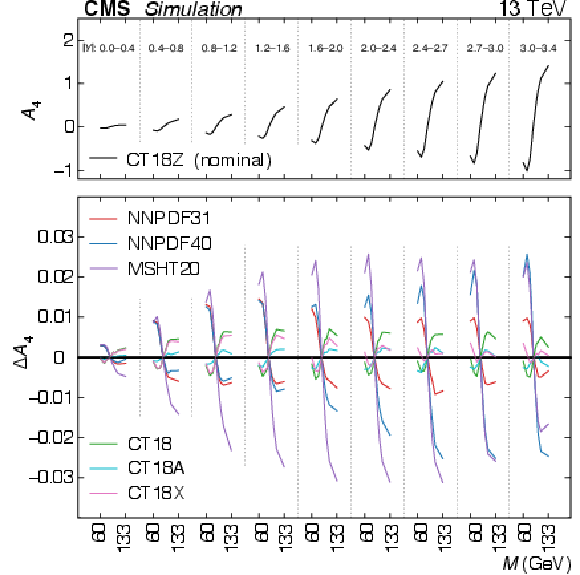
png pdf |
Figure 5-b:
Dilepton mass (left), rapidity (middle), and $ \cos\theta_\mathrm{CS} $ (right) distributions, for the $ \mu\mu $ (upper) and $ \mathrm{e}\mathrm{h} $ (lower) channels in the 2018 sample, after applying all the corrections. The signal is scaled to match the total number of events in the data. |

png pdf |
Figure 5-c:
Dilepton mass (left), rapidity (middle), and $ \cos\theta_\mathrm{CS} $ (right) distributions, for the $ \mu\mu $ (upper) and $ \mathrm{e}\mathrm{h} $ (lower) channels in the 2018 sample, after applying all the corrections. The signal is scaled to match the total number of events in the data. |
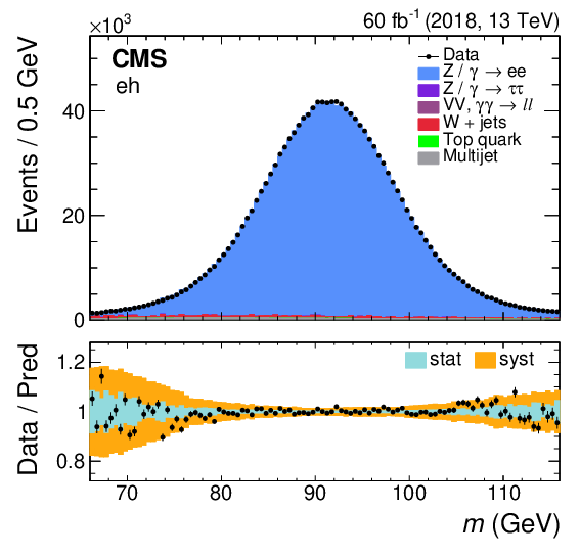
png pdf |
Figure 5-d:
Dilepton mass (left), rapidity (middle), and $ \cos\theta_\mathrm{CS} $ (right) distributions, for the $ \mu\mu $ (upper) and $ \mathrm{e}\mathrm{h} $ (lower) channels in the 2018 sample, after applying all the corrections. The signal is scaled to match the total number of events in the data. |

png pdf |
Figure 5-e:
Dilepton mass (left), rapidity (middle), and $ \cos\theta_\mathrm{CS} $ (right) distributions, for the $ \mu\mu $ (upper) and $ \mathrm{e}\mathrm{h} $ (lower) channels in the 2018 sample, after applying all the corrections. The signal is scaled to match the total number of events in the data. |
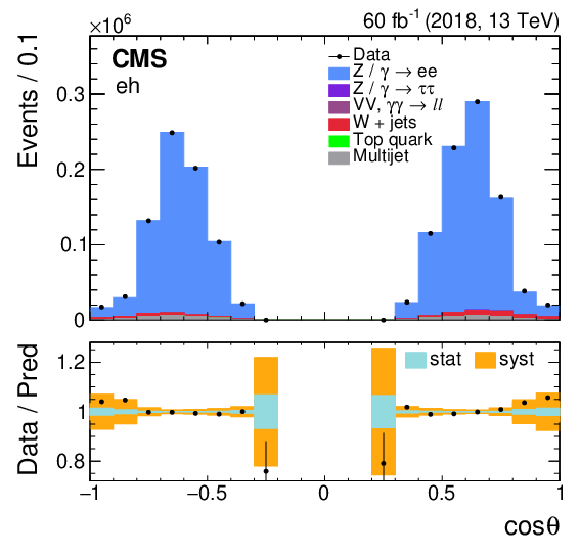
png pdf |
Figure 5-f:
Dilepton mass (left), rapidity (middle), and $ \cos\theta_\mathrm{CS} $ (right) distributions, for the $ \mu\mu $ (upper) and $ \mathrm{e}\mathrm{h} $ (lower) channels in the 2018 sample, after applying all the corrections. The signal is scaled to match the total number of events in the data. |
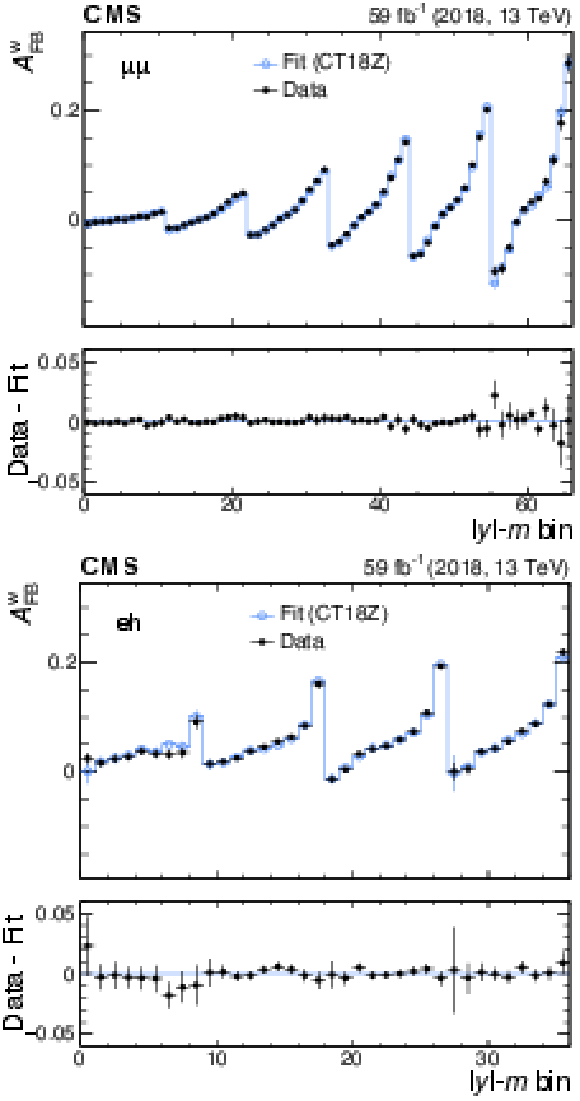
png pdf |
Figure 6:
The $ A_4 $ coefficient in the nominal configuration (upper panels) and its variations (lower panels) when changing the inputs mentioned in the legends: different POWHEG -Z\_ew options (left) and different PDF sets (right). No lepton kinematic selection criteria are applied. The size of the $ \sin^2\theta_\text{eff}^{\ell} $ variation is chosen for a clear visual demonstration. |
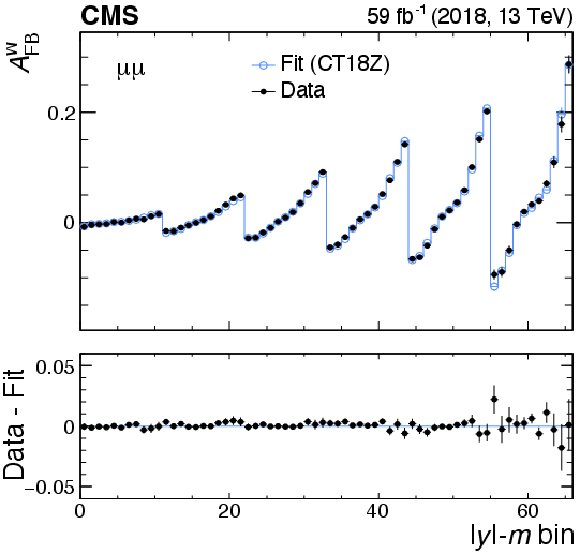
png pdf |
Figure 6-a:
The $ A_4 $ coefficient in the nominal configuration (upper panels) and its variations (lower panels) when changing the inputs mentioned in the legends: different POWHEG -Z\_ew options (left) and different PDF sets (right). No lepton kinematic selection criteria are applied. The size of the $ \sin^2\theta_\text{eff}^{\ell} $ variation is chosen for a clear visual demonstration. |
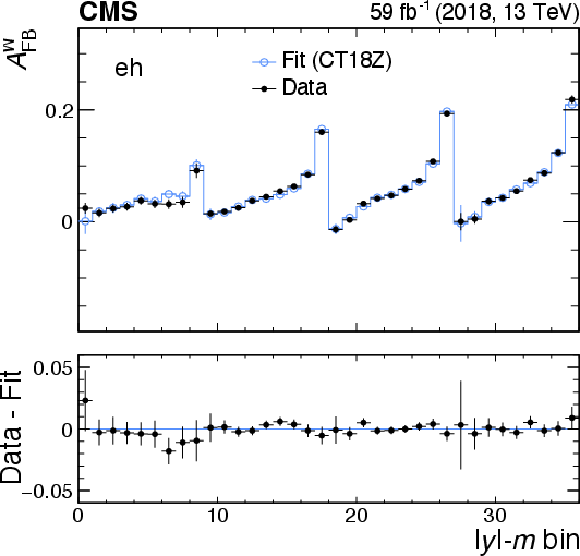
png pdf |
Figure 6-b:
The $ A_4 $ coefficient in the nominal configuration (upper panels) and its variations (lower panels) when changing the inputs mentioned in the legends: different POWHEG -Z\_ew options (left) and different PDF sets (right). No lepton kinematic selection criteria are applied. The size of the $ \sin^2\theta_\text{eff}^{\ell} $ variation is chosen for a clear visual demonstration. |

png pdf |
Figure 7:
Measured and best fit $ \mu\mu $ (left) and $ \mathrm{e}\mathrm{h} $ (right) $ A_\mathrm{FB}^\mathrm{w}(|y|,m) $ distributions for the 2018 data. The error bars represent the statistical uncertainties in the measured and simulated samples. The rapidity bins are given in Table 2. |

png pdf |
Figure 7-a:
Measured and best fit $ \mu\mu $ (left) and $ \mathrm{e}\mathrm{h} $ (right) $ A_\mathrm{FB}^\mathrm{w}(|y|,m) $ distributions for the 2018 data. The error bars represent the statistical uncertainties in the measured and simulated samples. The rapidity bins are given in Table 2. |
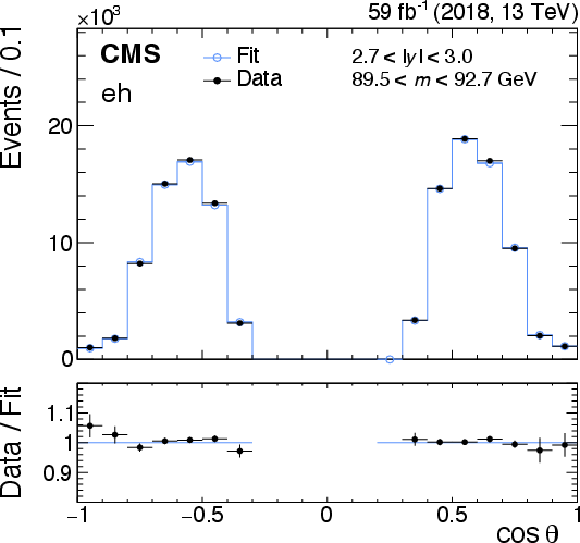
png pdf |
Figure 7-b:
Measured and best fit $ \mu\mu $ (left) and $ \mathrm{e}\mathrm{h} $ (right) $ A_\mathrm{FB}^\mathrm{w}(|y|,m) $ distributions for the 2018 data. The error bars represent the statistical uncertainties in the measured and simulated samples. The rapidity bins are given in Table 2. |

png pdf |
Figure 8:
Measured and best fit $ \mu\mu $ (left) and $ \mathrm{e}\mathrm{h} $ (right) $ \cos\theta_\mathrm{CS} $ distributions for 2018, for the Z boson peak and two rapidity bins. The error bars represent the statistical uncertainties. |

png pdf |
Figure 8-a:
Measured and best fit $ \mu\mu $ (left) and $ \mathrm{e}\mathrm{h} $ (right) $ \cos\theta_\mathrm{CS} $ distributions for 2018, for the Z boson peak and two rapidity bins. The error bars represent the statistical uncertainties. |

png pdf |
Figure 8-b:
Measured and best fit $ \mu\mu $ (left) and $ \mathrm{e}\mathrm{h} $ (right) $ \cos\theta_\mathrm{CS} $ distributions for 2018, for the Z boson peak and two rapidity bins. The error bars represent the statistical uncertainties. |

png pdf |
Figure 9:
Measured and best fit $ A_4(|Y|, M) $ distributions for the combined 2016-2018 fit with the CT18Z PDF set. The shaded band represents the post-fit PDF uncertainty. |
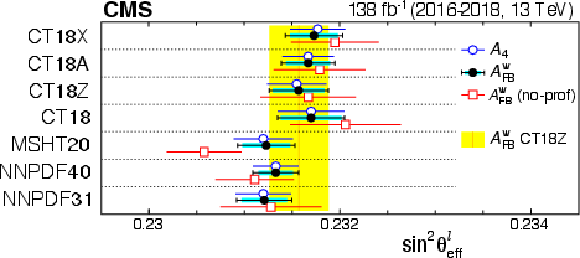
png pdf |
Figure 10:
Values of $ \sin^2\theta_\text{eff}^{\ell} $ measured with the $ A_\mathrm{FB}^\mathrm{w} $, $ A_4 $, and $ \cos\theta_\mathrm{CS} $ fits, in each of the four channels using the full 2016-2018 sample (upper) and in each of the four data-taking periods combining the four channels (lower), always with the CT18Z PDF set. The ``comb" band shows the result for all channels and runs combined. For the $ A_\mathrm{FB}^\mathrm{w} $ results, the magenta bands show the combined statistical and experimental systematic uncertainties, and the black bars represent the total uncertainties. |

png pdf |
Figure 11:
Values of $ \sin^2\theta_\text{eff}^{\ell} $ measured with the $ A_\mathrm{FB}^\mathrm{w} $ and $ A_4 $ fits, for seven PDF sets, combining the four channels and using the full 2016-2018 sample. The orange line and yellow band correspond to the result obtained with the CT18Z PDFs. The red open squares are the results obtained without profiling the corresponding PDF uncertainties. For the $ A_\mathrm{FB}^\mathrm{w} $ results, the cyan bands show the PDF uncertainties and the black bars represent the total uncertainties. |
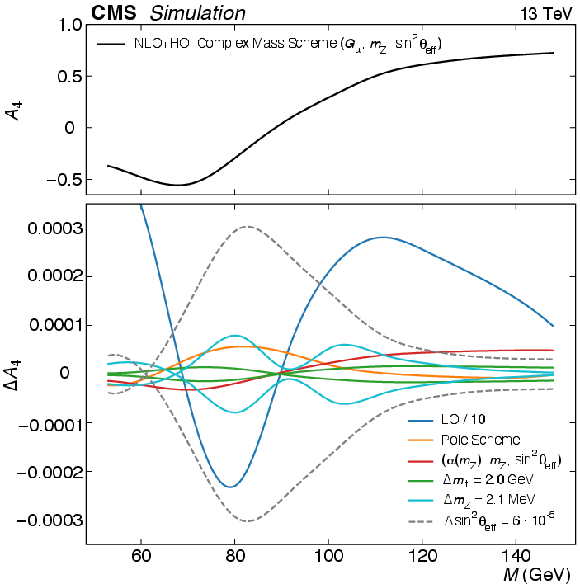
png pdf |
Figure 12:
Comparison of the $ \sin^2\theta_\text{eff}^{\ell} $ values measured in this analysis with previous measurements [1,11,12,9,10,14] and the result of a SM global fit [2]. |
| Tables | |
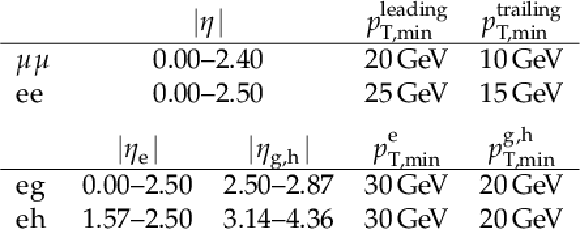
png pdf |
Table 1:
The lepton $ \eta $ and $ p_{\mathrm{T}} $ acceptance windows applied in the four measurement channels. The 1.44-1.57 $ |\eta| $ range, between the barrel and endcap ECAL, is excluded for central electrons. |
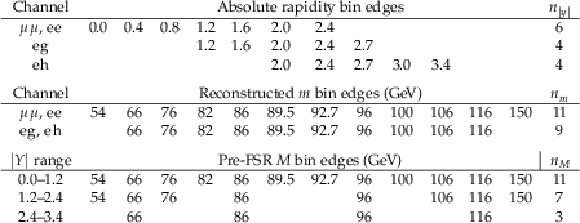
png pdf |
Table 2:
Dilepton rapidity and mass binning used in the fits; $ n_{|y|} $, $ n_m $, and $ n_M $ are the numbers of bins in each category. |

png pdf |
Table 3:
Free parameters in the $ A_\mathrm{FB}^\mathrm{w}(|y|,m) $ fit, indicating the number of independent variations ($ \mbox{e.g.} $, number of rapidity bins where the uncertainties are considered uncorrelated). Some of the total values reflect the four data-taking periods and/or the four final-state channels. |

png pdf |
Table 4:
Fitted $ \sin^2\theta_\text{eff}^{\ell} $ (in units of $ 10^{-5} $) for the four channels and their sum ($ \ell\ell $), using the full data sample. The fit quality is good, as indicated by the $ \chi^2 $ probabilities ($ p $). The experimental systematic uncertainties (``exp") are the sum of the values in the five rightmost columns, corresponding to the statistical uncertainties of the MC samples and the categories listed in Table 3. |
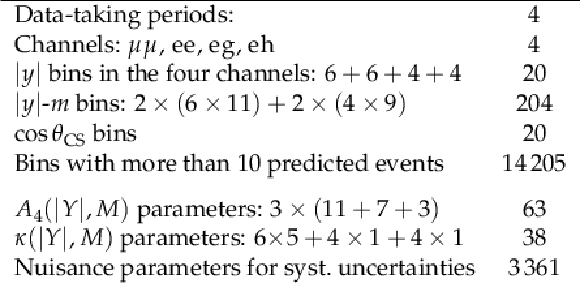
png pdf |
Table 5:
Numbers of bins and free parameters used in the unfolding. |
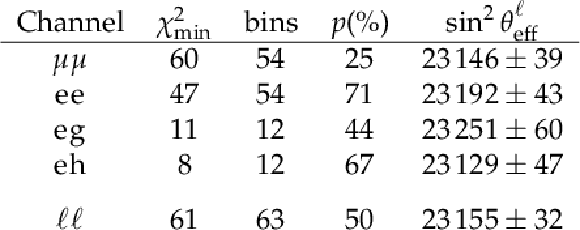
png pdf |
Table 6:
Measured $ \sin^2\theta_\text{eff}^{\ell} $ values (in units of $ 10^{-5} $) when using the $ A_4(|Y|, M) $ distributions for the four final-state channels and their sum. |

png pdf |
Table 7:
Values of $ \sin^2\theta_\text{eff}^{\ell} $ (in units of $ 10^{-5} $) obtained by fitting the measured $ A_\mathrm{FB}^\mathrm{w} $ or unfolded $ A_4 $, for seven PDF sets, combining the four channels and using the full 2016-2018 sample. |

png pdf |
Table 8:
Values of $ \sin^2\theta_\text{eff}^{\ell} $ (in units of $ 10^{-5} $) extracted by profiling the $ A_4 $ distribution (with 63 data points) using XFITTER, for several PDF sets. The reported uncertainties are the total ones, including contributions from the statistical, experimental systematic, theoretical, and PDF sources. |

png pdf |
Table 9:
Values of $ \sin^2\theta_\text{eff}^{\ell} $ (in units of $ 10^{-5} $) extracted by profiling the $ A_4 $ distribution (with 63 data points) using XFITTER, for several PDF sets. The reported uncertainties are the total ones, including contributions from the statistical, experimental systematic, theoretical, and PDF sources. |
| Summary |
| A precise measurement of the forward-backward asymmetry has been performed, using proton-proton collisions at $ \sqrt{s} = $ 13 TeV collected in 2016-2018 by the CMS experiment and corresponding to a total integrated luminosity of 138 fb$ ^{-1} $. The measurement is based on the study of Drell-Yan dimuon and dielectron events. The effective leptonic electroweak mixing angle $ \sin^2\theta_\text{eff}^{\ell} $ is extracted very precisely by fitting the detector-level angular-weighted $ A_\mathrm{FB}^\mathrm{w}(|y|,m) $ and the unfolded $ A_4(|Y|, M) $ angular coefficient of the pre-FSR dilepton, obtaining compatible results. Given that the angular-weighted asymmetry method [17] benefits from the cancelation of systematic uncertainties in the detection acceptance and efficiencies, we use this method for our baseline result. This measurement has a significantly smaller uncertainty than the previous CMS result [14] because of the larger data sample, an improved analysis technique, and the inclusion of central-forward dielectron configurations. Using the CT18Z set of parton distribution functions we obtain $ \sin^2\theta_\text{eff}^{\ell} $ = 0.23152 $\pm$ 0.00010 (stat) $\pm$ 0.00015 (exp) $\pm$ 0.00008 (theo) $\pm$ 0.00027 (PDF), where ``stat", ``exp", ``theo", and ``PDF" denote, respectively, the statistical uncertainty and the systematic uncertainties reflecting experimental effects, the theory modeling, and the PDFs. Accounting for the correlations between the various contributions, the total uncertainty, dominated by the PDF term, is 0.00031. It varies between 0.00024 and 0.00035 depending on the PDF set. From the unfolded $ A_4(|Y|, M) $ angular coefficient, and using the CT18Z PDF set, the extracted $ \sin^2\theta_\text{eff}^{\ell} $ value is 0.23154 $ \pm $ 0.00032 or 0.23152 $ \pm $ 0.00032, depending on the analysis framework. Our result agrees with the standard model expectation, 0.23155 $ \pm $ 0.00004, and is the most precise hadron-collider measurement. The precision is comparable to that of the two most precise measurements performed in $ \mathrm{e}^+\mathrm{e}^- $ collisions at LEP and SLD, with respective uncertainties of 0.00029 and 0.00026. The $ A_4 $ coefficient, measured as a function of the dilepton mass and rapidity, can be used in combination with other LHC measurements or to improve the $ \sin^2\theta_\text{eff}^{\ell} $ measurement using future PDF sets. |
| References | ||||
| 1 | ALEPH, DELPHI, L3, OPAL, SLD, LEP Electroweak Working Group, SLD Electroweak Group, SLD Heavy Flavour Group Collaboration | Precision electroweak measurements on the Z resonance | Phys. Rept. 427 (2006) 257 | hep-ex/0509008 |
| 2 | Particle Data Group Collaboration | Review of Particle Physics | PTEP 2022 (2022) 083C01 | |
| 3 | D0 Collaboration | Measurement of the forward-backward charge asymmetry and extraction of $ \sin^2\theta_W^{\text{eff}} $ in $ \mathrm{p}\overline{\mathrm{p}} \rightarrow \mathrm{Z}/\gamma^{\ast}+X \rightarrow \mathrm{e}^+\mathrm{e}^- + X $ events produced at $ \sqrt{s}= $ 1.96 TeV | PRL 101 (2008) 191801 | 0804.3220 |
| 4 | D0 Collaboration | Measurement of $ \sin^2\theta_\text{eff}^{\ell} $ and Z-light quark couplings using the forward-backward charge asymmetry in $ \mathrm{p}\overline{\mathrm{p}} \to \mathrm{Z}/\gamma^{\ast} \to \mathrm{e}^+\mathrm{e}^- $ events with $ {\cal L}= $ 5.0 fb$ ^{-1} $ at $ \sqrt{s}= $ 1.96 TeV | PRD 84 (2011) 012007 | 1104.4590 |
| 5 | CMS Collaboration | Measurement of the weak mixing angle with the Drell-Yan process in proton-proton collisions at the LHC | PRD 84 (2011) 112002 | CMS-EWK-11-003 1110.2682 |
| 6 | CDF Collaboration | Indirect measurement of $ \sin^2\theta_W (M_\mathrm{W}) $ using $ \mathrm{e}^+\mathrm{e}^- $ pairs in the Z-boson region with $ \mathrm{p}\overline{\mathrm{p}} $ collisions at a center-of-momentum energy of 1.96 TeV | PRD 88 (2013) 072002 | 1307.0770 |
| 7 | CDF Collaboration | Indirect measurement of $ \sin^2 \theta_W $ (or $ M_\mathrm{W} $) using $ \mu^{+}\mu^{-} $ pairs from $ \gamma^{\ast}/\mathrm{Z} $ bosons produced in $ \mathrm{p}\overline{\mathrm{p}} $ collisions at a center-of-momentum energy of 1.96 TeV | PRD 89 (2014) 072005 | 1402.2239 |
| 8 | D0 Collaboration | Measurement of the effective weak mixing angle in $ \mathrm{p}\overline{\mathrm{p}} \rightarrow \mathrm{Z}/\gamma^{\ast}\rightarrow \mathrm{e}^+\mathrm{e}^- $ events | PRL 115 (2015) 041801 | 1408.5016 |
| 9 | ATLAS Collaboration | Measurement of the forward-backward asymmetry of electron and muon pair-production in pp collisions at $ \sqrt{s} = $ 7 TeV with the ATLAS detector | JHEP 09 (2015) 049 | 1503.03709 |
| 10 | LHCb Collaboration | Measurement of the forward-backward asymmetry in $ \mathrm{Z}/\gamma^{\ast} \rightarrow \mu^{+}\mu^{-} $ decays and determination of the effective weak mixing angle | JHEP 11 (2015) 190 | 1509.07645 |
| 11 | CDF Collaboration | Measurement of $ \sin^2\theta^\text{lept}_\text{eff} $ using $ \mathrm{e}^+\mathrm{e}^- $ pairs from $ \gamma^{\ast}/\mathrm{Z} $ bosons produced in $ \mathrm{p}\overline{\mathrm{p}} $ collisions at a center-of-momentum energy of 1.96 TeV | PRD 93 (2016) 112016 | 1605.02719 |
| 12 | D0 Collaboration | Measurement of the effective weak mixing angle in $ \mathrm{p}\overline{\mathrm{p}} \rightarrow \mathrm{Z}/\gamma^{\ast} \rightarrow \ell^+\ell^- $ events | PRL 120 (2018) 241802 | 1710.03951 |
| 13 | CDF and D0 collaborations | Tevatron Run II combinations of the effective leptonic electroweak mixing angle | PRD 97 (2018) 112007 | 1801.06283 |
| 14 | CMS Collaboration | Measurement of the weak mixing angle using the forward-backward asymmetry of Drell-Yan events in pp collisions at 8 TeV | EPJC 78 (2018) 701 | CMS-SMP-16-007 1806.00863 |
| 15 | J. C. Collins and D. E. Soper | Angular distribution of dileptons in high-energy hadron collisions | PRD 16 (1977) 2219 | |
| 16 | P. Faccioli and C. Lourenço | Particle polarization in high energy physics: an introduction and case studies on vector particle production at the LHC | Lecture Notes in Physics. Springer, 2022 link |
|
| 17 | A. Bodek | A simple event weighting technique for optimizing the measurement of the forward-backward asymmetry of Drell-Yan dilepton pairs at hadron colliders | EPJC 67 (2010) 321 | 0911.2850 |
| 18 | CMS Collaboration | The CMS experiment at the CERN LHC | JINST 3 (2008) S08004 | |
| 19 | CMS Collaboration | Development of the CMS detector for the CERN LHC Run 3 | JINST 19 (2024) P05064 | CMS-PRF-21-001 2309.05466 |
| 20 | CMS Collaboration | Performance of the CMS Level-1 trigger in proton-proton collisions at $ \sqrt{s} = $ 13 TeV | JINST 15 (2020) P10017 | CMS-TRG-17-001 2006.10165 |
| 21 | CMS Collaboration | The CMS trigger system | JINST 12 (2017) P01020 | CMS-TRG-12-001 1609.02366 |
| 22 | CMS Collaboration | Electron and photon reconstruction and identification with the CMS experiment at the CERN LHC | JINST 16 (2021) P05014 | CMS-EGM-17-001 2012.06888 |
| 23 | CMS Collaboration | Performance of the CMS muon detector and muon reconstruction with proton-proton collisions at $ \sqrt{s} = $ 13 TeV | JINST 13 (2018) P06015 | CMS-MUO-16-001 1804.04528 |
| 24 | CMS Collaboration | Description and performance of track and primary-vertex reconstruction with the CMS tracker | JINST 9 (2014) P10009 | CMS-TRK-11-001 1405.6569 |
| 25 | CMS Collaboration | Particle-flow reconstruction and global event description with the CMS detector | JINST 12 (2017) P10003 | CMS-PRF-14-001 1706.04965 |
| 26 | CMS HCAL Collaboration | Design, performance and calibration of the CMS forward calorimeter wedges | EPJC 53 (2008) 139 | |
| 27 | CMS Collaboration | Performance of reconstruction and identification of $ \tau $ leptons decaying to hadrons and $ \nu_\tau $ in pp collisions at $ \sqrt{s}= $ 13 TeV | JINST 13 (2018) P10005 | CMS-TAU-16-003 1809.02816 |
| 28 | CMS Collaboration | Jet energy scale and resolution in the CMS experiment in pp collisions at 8 TeV | JINST 12 (2017) P02014 | CMS-JME-13-004 1607.03663 |
| 29 | CMS Collaboration | Performance of missing transverse momentum reconstruction in proton-proton collisions at $ \sqrt{s} = $ 13 TeV using the CMS detector | JINST 14 (2019) P07004 | CMS-JME-17-001 1903.06078 |
| 30 | CMS Collaboration | Strategies and performance of the CMS silicon tracker alignment during LHC Run 2 | NIM A 1037 (2022) 166795 | CMS-TRK-20-001 2111.08757 |
| 31 | CMS Collaboration | Precision luminosity measurement in proton-proton collisions at $ \sqrt{s} = $ 13 TeV in 2015 and 2016 at CMS | EPJC 81 (2021) 800 | CMS-LUM-17-003 2104.01927 |
| 32 | CMS Collaboration | CMS luminosity measurement for the 2017 data-taking period at $ \sqrt{s} = $ 13 TeV | CMS Physics Analysis Summary, 2018 link |
CMS-PAS-LUM-17-004 |
| 33 | CMS Collaboration | CMS luminosity measurement for the 2018 data-taking period at $ \sqrt{s} = $ 13 TeV | CMS Physics Analysis Summary, 2019 link |
CMS-PAS-LUM-18-002 |
| 34 | CMS Collaboration | Performance of the CMS muon trigger system in proton-proton collisions at $ \sqrt{s} = $ 13 TeV | JINST 16 (2021) P07001 | CMS-MUO-19-001 2102.04790 |
| 35 | TMVA Collaboration | TMVA: Toolkit for multivariate data analysis | AIP Conf. Proc. 1504 (2012) 1013 | |
| 36 | M. Cacciari, G. P. Salam, and G. Soyez | The anti-$ k_{\mathrm{T}} $ jet clustering algorithm | JHEP 04 (2008) 063 | 0802.1189 |
| 37 | M. Abadi et al. | TensorFlow: large-scale machine learning on heterogeneous distributed systems | link | 1603.04467 |
| 38 | S. Frixione, P. Nason, and C. Oleari | Matching NLO QCD computations with parton shower simulations: the POWHEG method | JHEP 11 (2007) 070 | 0709.2092 |
| 39 | S. Alioli, P. Nason, C. Oleari, and E. Re | A general framework for implementing NLO calculations in shower Monte Carlo programs: the POWHEG BOX | JHEP 06 (2010) 043 | 1002.2581 |
| 40 | P. F. Monni et al. | MiNNLO$ _\mathrm{PS} $: a new method to match NNLO QCD to parton showers | JHEP 05 (2020) 143 | 1908.06987 |
| 41 | P. F. Monni, E. Re, and M. Wiesemann | MiNNLO$ _{\mathrm{PS}} $: optimizing 2 $ \rightarrow $ 1 hadronic processes | EPJC 80 (2020) 1075 | 2006.04133 |
| 42 | T. Sjöstrand et al. | An introduction to PYTHIA8.2 | Comput. Phys. Commun. 191 (2015) 159 | 1410.3012 |
| 43 | E. Barberio and Z. Was | PHOTOS: A universal Monte Carlo for QED radiative corrections. Version 2.0 | Comput. Phys. Commun. 79 (1994) 291 | |
| 44 | P. Golonka and Z. Was | PHOTOS Monte Carlo: A precision tool for QED corrections in Z and W decays | EPJC 45 (2006) 97 | hep-ph/0506026 |
| 45 | NNPDF Collaboration | Parton distributions from high-precision collider data | EPJC 77 (2017) 663 | 1706.00428 |
| 46 | NNPDF Collaboration | The path to proton structure at 1\% accuracy | EPJC 82 (2022) 428 | 2109.02653 |
| 47 | T.-J. Hou et al. | New CTEQ global analysis of quantum chromodynamics with high-precision data from the LHC | PRD 103 (2021) 014013 | 1912.10053 |
| 48 | S. Bailey et al. | Parton distributions from LHC, HERA, Tevatron and fixed target data: MSHT20 PDFs | EPJC 81 (2021) 341 | 2012.04684 |
| 49 | J. Butterworth et al. | PDF4LHC recommendations for LHC Run II | JPG 43 (2016) 023001 | 1510.03865 |
| 50 | J. Alwall et al. | The automated computation of tree-level and next-to-leading order differential cross sections, and their matching to parton shower simulations | JHEP 07 (2014) 079 | 1405.0301 |
| 51 | GEANT4 Collaboration | GEANT 4-a simulation toolkit | NIM A 506 (2003) 250 | |
| 52 | CMS Collaboration | Measurement of the inelastic proton-proton cross section at $ \sqrt{s}= $ 13 TeV | JHEP 07 (2018) 161 | CMS-FSQ-15-005 1802.02613 |
| 53 | L. Barzè et al. | Neutral current Drell-Yan with combined QCD and electroweak corrections in the POWHEG BOX | EPJC 73 (2013) 2474 | 1302.4606 |
| 54 | M. Chiesa, F. Piccinini, and A. Vicini | Direct determination of $ \sin^2 \theta^\ell_\text{eff} $ at hadron colliders | PRD 100 (2019) 071302 | 1906.11569 |
| 55 | M. Chiesa, C. L. Del Pio, and F. Piccinini | On electroweak corrections to neutral current Drell-Yan with the POWHEG BOX | EPJC 84 (2024) 539 | 2402.14659 |
| 56 | CMS Collaboration | Measurement of the inclusive W and Z production cross sections in pp collisions at $ \sqrt{s}= $ 7 TeV | JHEP 10 (2011) 132 | CMS-EWK-10-005 1107.4789 |
| 57 | A. Bodek et al. | Extracting muon momentum scale corrections for hadron collider experiments | EPJC 72 (2012) 2194 | 1208.3710 |
| 58 | B. Efron | Bootstrap methods: another look at the jackknife | Annals Statist. 7 (1979) 1 | |
| 59 | A. Bodek, J. Han, A. Khukhunaishvili, and W. Sakumoto | Using Drell-Yan forward-backward asymmetry to reduce PDF uncertainties in the measurement of electroweak parameters | EPJC 76 (2016) 115 | 1507.02470 |
| 60 | CMS Collaboration | Measurement of associated production of a W boson and a charm quark in proton-proton collisions at $ \sqrt{s} = $ 13 TeV | EPJC 79 (2019) 269 | CMS-SMP-17-014 1811.10021 |
| 61 | CMS Collaboration | Measurement of the muon charge asymmetry in inclusive $ \mathrm{p}\mathrm{p} \to \mathrm{W} + X $ production at $ \sqrt{s} = $ 7 TeV and an improved determination of light parton distribution functions | PRD 90 (2014) 032004 | CMS-SMP-12-021 1312.6283 |
| 62 | F. James and M. Roos | Minuit - a system for function minimization and analysis of the parameter errors and correlations | Comput. Phys. Commun. 10 (1975) 343 | |
| 63 | D. C. Liu and J. Nocedal | On the limited memory BFGS method for large scale optimization | Math. Programming 45 (1989) 503 | |
| 64 | T. Cridge, L. A. Harland-Lang, and R. S. Thorne | Combining QED and approximate N$ ^3 $LO QCD corrections in a global PDF fit: MSHT20qed_an3lo PDFs | 2312.07665 | |
| 65 | S. Alekhin et al. | HERAFitter | EPJC 75 (2015) 304 | 1410.4412 |
| 66 | HERAFitter developers' Team Collaboration | QCD analysis of W- and Z-boson production at Tevatron | EPJC 75 (2015) 458 | 1503.05221 |
| 67 | C. Schwan | PineAPPL: NLO EW corrections for PDF processes | SciPost Phys. Proc. 8 (2022) 079 | 2108.05816 |
| 68 | S. Carrazza, E. R. Nocera, C. Schwan, and M. Zaro | PineAPPL: combining EW and QCD corrections for fast evaluation of LHC processes | JHEP 12 (2020) 108 | 2008.12789 |
| 69 | NNPDF Collaboration | The path to $ \hbox {N}^3\hbox {LO} $ parton distributions | EPJC 84 (2024) 659 | 2402.18635 |
| 70 | NNPDF Collaboration | Determination of the theory uncertainties from missing higher orders on NNLO parton distributions with percent accuracy | EPJC 84 (2024) 517 | 2401.10319 |
| 71 | S. Alekhin, J. Blümlein, S. Moch, and R. Placakyte | Parton distribution functions, $ \alpha_s $, and heavy-quark masses for LHC Run II | PRD 96 (2017) 014011 | 1701.05838 |
| 72 | PDF4LHC Working Group Collaboration | The PDF4LHC21 combination of global PDF fits for the LHC Run III | JPG 49 (2022) 080501 | 2203.05506 |
| 73 | T.-J. Hou, H.-W. Lin, M. Yan, and C. P. Yuan | Impact of lattice strangeness asymmetry data in the CTEQ-TEA global analysis | PRD 107 (2023) 076018 | 2211.11064 |
| 74 | H1, ZEUS Collaboration | Combination of measurements of inclusive deep inelastic $ {\mathrm{e}^{\pm }\mathrm{p}} $ scattering cross sections and QCD analysis of HERA data | EPJC 75 (2015) 580 | 1506.06042 |
| 75 | CMS Collaboration | HEPData record for this analysis | link | |

|
Compact Muon Solenoid LHC, CERN |

|

|

|

|

|

|